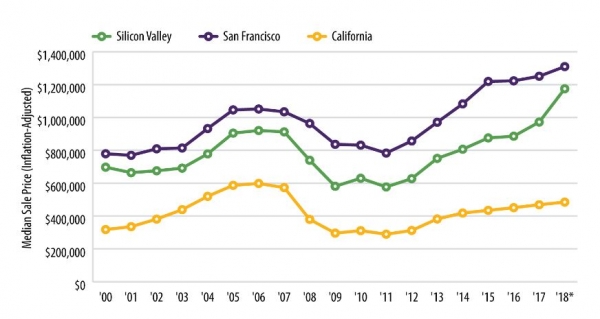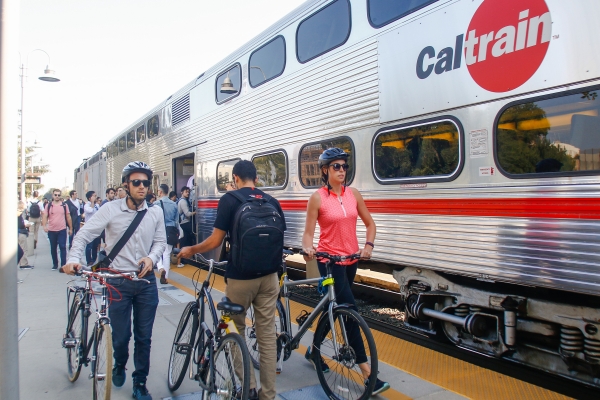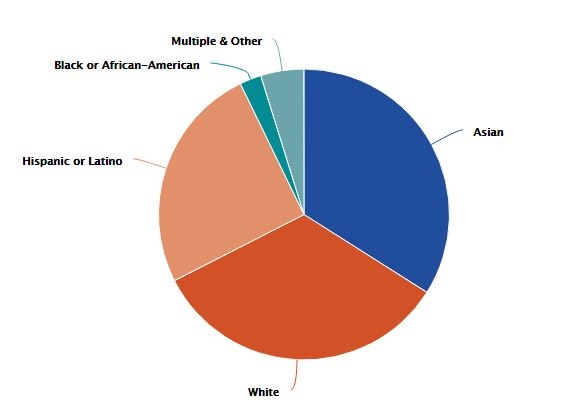Despite a sizzling economy and an influx of wealth, Silicon Valley remains a bastion of inequality, with more residents now struggling to afford the growing costs of housing, child care and transportation, according to a newly released snapshot of the regional economy.
The 2019 Silicon Valley Index, which was released this week by Joint Venture Silicon Valley, paints a troubling picture of a region where home prices continue to skyrocket, where tech giants are voraciously gobbling up startups and where more people are leaving than coming in.
These trends are casting a shadow over the region's continuous economic expansion, with $50 billion in venture capital flowing to area companies and average annual earnings reaching $140,000, more than double the national average.
In his introduction of the annual report, Joint Venture President and CEO Russell Hancock called this year's report a "Rorschach test," with plenty to both cheer and worry about. Hancock noted that some of the challenges, including transportation's woes, sky-high housing costs, and a "yawning income divide," remain troubling but are, in a sense, "old news."
More disquieting, he wrote, are indicators that the region's "fundamentals" — which have driven the area's economic vitality — could be changing.
Among the factors, he wrote, large companies are "acquiring smaller ones at a pace we've never seen, changing the messy way innovation has typically happened here, perhaps even stifling it."
"Fewer startups are getting their seed funding," Hancock wrote. "Our high costs (including salaries) are causing innovative companies to look elsewhere."
For the third year in a row, Silicon Valley has seen more people move out than move in, the report states. Between July 2017 and July 2018, Santa Clara County had a net "out migration" of domestic residents of about 15,000, trailing only Los Angeles and Orange counties. Strikingly, foreign immigrants are also leaving in greater numbers than coming in. Between July 2015 and July 2018, the region gained 61,977 foreign immigrants but lost 64,318 to other parts of California and the United States.
"The influx of foreign immigrants into the region is more than fully offset by the number of Silicon Valley residents moving to other parts of the state and nation; those who choose to stay within California are heading to regions such as the Sacramento and Stockton/Tracy areas where housing costs are significant lower," the report states.
The report also takes note of the region's slowing population growth, which is due primarily to the region's slow and declining birth rate.
At the same time, Silicon Valley remains a diverse region. The report showed that in 2017, Asian residents made up 34 percent of the population, marking the first time that they have represented the largest share of the region's population (in 2007 they accounted for 28 percent of the population). The percentage of white residents has decreased from 40.4 percent in 2007 to 33.5 percent in 2017, the report states.
The report also underscores the region's failures, despite recent statewide and local efforts, to increase residential development and lower housing costs. Median home prices in Silicon Valley skyrocketed in 2018, going up by a whopping 21 percent and reaching $1.18 million, the report states. And while rental rates in the San Francisco and San Jose metro areas remained steady in 2018, they were significantly higher than in any other metro area in the nation (in these two areas, rental rates are $3.42 and $3.20 per square foot, respectively; New York is a distant third at $2.67 per square foot).
Housing supply has not come anywhere close to keeping up with demand: While the region has produced close to 18,000 new units over the past two years, the new projects have not come close to making up for insufficient building over the prior decade, according to the report. The Index estimates that between 2007 and 2016, Silicon Valley created a housing shortage of about 38,000 units, which would be needed to accommodate the region's growing population.
Furthermore, new buildings are generally priced for the wealthy. Only 8 percent of newly approved residential units in Silicon Valley are affordable to residents who earn less than 80 percent of the area median income. For most potential first-time homebuyers, local prices remain far out of reach. The report shows that only 22 percent of potential-first-time homebuyers in San Mateo County — and 30 percent in Santa Clara County — can afford a median-priced home.
The lack of affordable housing, the report notes, "results in longer commutes, diminished productivity, curtailment of family time, and increased traffic congestion."
"It also restricts the ability of crucial service providers — such as teachers, registered nurses, and police officers — to live near the communities they work," the report states. "Additionally, high housing costs can limit families' ability to pay for basic needs, such as food, health care, transportation, child care and clothing. They can push residents to live with one another for economic reasons and can increase homelessness."
Despite a recent push by traditionally growth-averse cities like Palo Alto to encourage more housing, the pace of construction remains sluggish. The number of residential units that were permitted in Silicon Valley in 2018 — 8,400 — was actually lower than in 2017, when more than 9,000 units received the green light.
The report underscores the region's growing income gap, with the number of high-income households (earning $150,000 or more) in Silicon Valley and San Francisco rising by 35 percent in the past four years and 2 percent of households claiming 27 percent of the wealth. Furthermore, more than a quarter of Silicon Valley households have household incomes above $200,000, compared to 11 percent statewide and 7 percent nationally.
But for those at the lower end of the income scale, affording a living has become considerably more difficult. One of the more eye-popping statistics in the new report is the rising cost of child care, which has gone up by 52 percent since 2012 and now stands at about $20,900 annually for infants. The cost of transportation needs for a family of four has gone up by 18 percent since 2014 and is now about $6,300.
The report points to income disparities that persist between "residents of various races and ethnicities, and between men and women at the same level of educational attainment." The tech industry continues to be dominated by men. Only 18 percent of highly educated women between the ages of 24 and 44 worked in technical occupations in 2017, compared to 43 percent of their male counterparts.
The report also showed that women made up just 28 percent of the workforce at Silicon Valley's largest tech companies in 2017, and a mere 19 percent of technical roles and leadership positions.
One finding that is unlikely to surprise readers is the growing commute times. Even though the average number of miles driven by Silicon Valley residents has declined for three consecutive years (reaching 22 miles in 2017), solo commuting remains the most popular option — one chosen by 72 percent of Silicon Valley workers (down from 75 percent a decade ago). The report notes that the average commute time has gone up by 20 percent over the past decade, adding an additional 43 hours of driving time per commuter annually. In 2017, 6.5 percent of employees spent more than three hours on their daily work commutes.
Likely driven by traffic congestion, the share of commuters taking public transportation rose, from 4.9 percent in 2011 to 6.5 percent in 2016. Ridership on Caltrain, a popular commute option on the Peninsula, rose between 2010 and 2018 by 45 percent.
The cost of transportation needs in Silicon Valley went up by 4 percent over the past four years, the report found, even as it decreased statewide by 12 percent over the same period.
"Changing transportation costs affect our residents' ability to get around and still afford their other basic needs," the report states. "And the amount of time wasted due to long commutes and traffic delays affects the everyday lives of our residents — taking time away from work, participating in the community, or being with family and friends."
View multiple charts illustrating the report's findings here.






Comments
another community
on Feb 19, 2019 at 4:53 pm
on Feb 19, 2019 at 4:53 pm
Perhaps there could be commuter airlines, with airplanes and helicopters, or charters to shuttle people from the central valley and Livermore to our regional public general aviation airports and possibly Moffett. They are close to freeways and employers.
HP has a hangar at San Jose Airport.
Helipads could be placed in the parking lots or atop garages operated by the large employers.
Why not encourage the other large employers to do think about this? It would be faster than the busses they currently operate.
On foul weather days, people could drive, telecommute or take a train.
Another Mountain View Neighborhood
on Feb 19, 2019 at 10:15 pm
on Feb 19, 2019 at 10:15 pm
@Robyn
Or we could build more high-density housing here instead of making everyone commute in by plane and helicopter.
another community
on Feb 20, 2019 at 3:36 am
on Feb 20, 2019 at 3:36 am
All flippant talk about commuters coming in from outside the Bay Area counties to work within the region is always out of perspective. Four MILLION total jobs in these counties are filled by a measly 150,000 workers making the crazy long commutes from the Central Valley or flying in on airplanes. You have to believe that some of these people have spouses with jobs that keep them elsewhere. Even if the entire 150,000 number were due to housing shortages, it pales into insignificance given the total 4 Million jobs involved. Commute aren't significantly from outside the region--there are apparently 96% of the workers who find homes "locally."
Cuesta Park
on Feb 20, 2019 at 10:31 am
on Feb 20, 2019 at 10:31 am
It is apparent that these fabulous commuter shuttles are only available for full time employees of the big tech companies. This means that all of their service providers do not get the perks of utilizing commuter services as do the techies. In a great deal of these companies, almost half of the employees are contractors, some are tech contractors and some are facilities contractors, and these folks are very often excluded from the perks, with commute buses being one of them. I think if these perks were available to all of the employees, that would certainly go a long way in relieving traffic congestion.
Bailey Park
on Feb 20, 2019 at 11:54 am
on Feb 20, 2019 at 11:54 am
High density market housing is THE SOLUTION BUT NOT IN NORTH BAY SHORE ONLY IN THE REST OF MOUNTAIN VIEW AND SURROUNDING COMMUNITIES SUCH AS LOS ALTOS AND LOS ALTOS HILLS.
Keep office concentrated fed by a transportation meca. The old guard City Council got it wrong with housing in North Bay Shore...bad idea.
A study should be done to see actually how many residents in subsidizied housing actually work at meaningful productive jobs. It started with fire fighters and police officers and has shifted to include everyone who wants to live in Mountain View, which is social policy gone astray.
another community
on Feb 20, 2019 at 4:29 pm
on Feb 20, 2019 at 4:29 pm
Building housing in North Bayshore is perfectly fine. The problem is they aren't planning on enough of it. Google has only begun to hire. They really have not added many employees in the space in North Bayshore, as nowadays they put 6-7 workers per 1000 square feet of office space. In the old days that number was 4. But right now they are planning, constructing, or almost done making a huge amount of new office space. Some was allowed under the zoning in place back in 2008. The NBS was not yet built out as envisioned even then. Wait till the new buildings come online over the next 5-10 years. Not only is Google's monopoly expanding in NBS, but they are building new office facilities at NASA Ames! Housing up there is essential.
Why is this so? Well, the city put trip caps on Google (originally also LinkedIn who sold out to Google). When they upped the total size of the offices a few years ago, they said it had to be done in such a way as to not have more vehicle trips into NBS. The city added about 3.4 Million square feet of office space BEYOND THE PREVIOUS limits which have still not been reached! That's an allowed addition of 20,000 more workers than the giant number already OKayed way back when. But we still don't have housing for the growth that just builds out to the OLD CAP. Google agreed that even with the margin from already-zoned being built out, there would be no net new vehicle trips into the area.
Pretty much the only way to do this is to have workers living in the same neighborhood. They also need a LOT of housing for the workers employed by Google but located at NASA Ames, another 10,000 maybe.
The city has okayed turning NBS into a dense urban center in its own right. It has to have apartment buildings. There is no way around this.
As for this idea of adding housing in Los Altos or Los Altos Hills, why the heck should they? Mountain View wanted the economic benefits for its shops and tax revenues of having another 50,000 workers north of 101. They set the stage for this. It's forecast to be a windfall of epic proportions for Mountain View. Why should Mountain View look to a city with near-Zero job growth (or even with job contraction) to house the workers Mountain View added to increase their revenue base?
another community
on Feb 20, 2019 at 4:34 pm
on Feb 20, 2019 at 4:34 pm
Also consider the Google has restaurants that feed their employees breakfast lunch and dinner. They have dry cleaners, fitness centers, car maintenance, dental care, medical care onsite. It would be much more convenient for the Google cadre to have their beds up by where they get their food! They wouldn't need kitchens! Basically what is needed up by Google is dorms for the designated workers. That's the only way the Google hive can be as busy as Google has indicated it will be in the future.